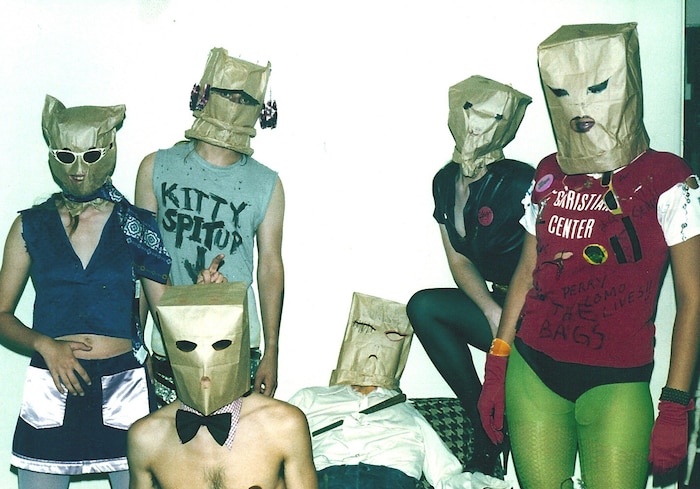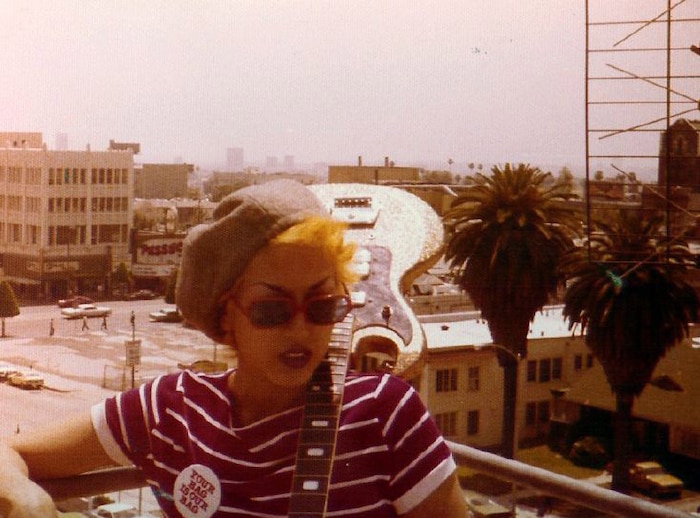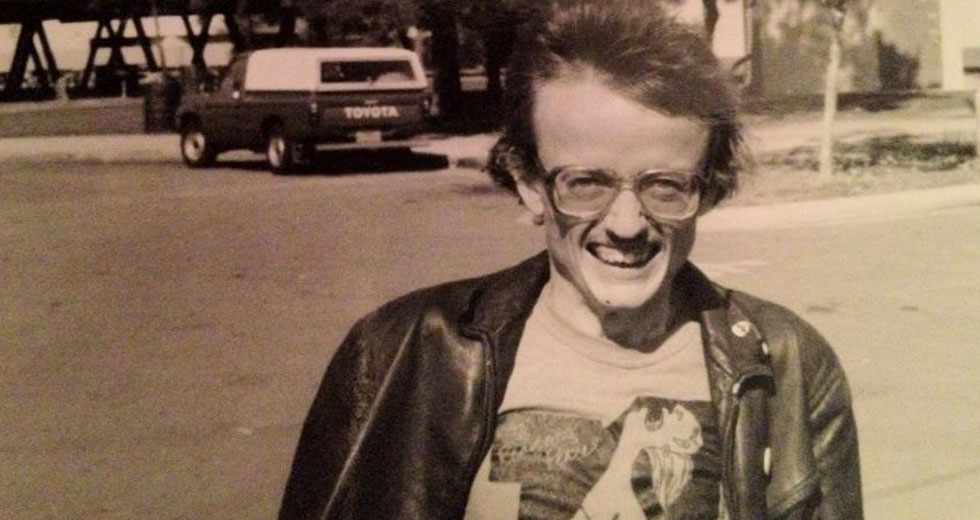Life at the Canterbury
The true story of the apartment building where LA punk truly became a scene

Hollywood is an idea and an export as much as it is a neighborhood. Yet in the late ’70s, a stone’s throw from where hopeful starlets dreamily roamed the Hollywood Walk of Fame, a different, distinct universe emerged off Hollywood and North Cherokee: Punk rock ground zero for Los Angeles.
Misfits inhabiting Los Angeles in the mid-’70s heard rumblings from New York and London, and were electrified, but LA punks – devoid of clubs and venues catering to their interests – rattled with anxiety, eager to make the kind of squalor they could call their own. “We were starving in more ways than one: Starving for music, starving for culture, starving for friends, ’cause it was kind of a lonely time,” says Geza X, a producer and musician who once played in the likes of the Bags and the Deadbeats. “And we were artists, particularly with Dada-esque interests. Nobody in LA was doing that at the time. It was so boring. It was so stale. Wonderbread. So in desperation we all found each other.”
Bored with the trend of singer-songwriter performances, like-minded miscreants soon took matters into their own hands. A nascent punk scene began bubbling up around 1976, with groups like the Screamers, Germs, the Weirdos and the Zeros forming. The next year, the Bags and the Go-Go’s, among others, began making noise wherever and however they could. “There was no clearly defined punk sound, no dress code; all you had to do was show up and make your presence known,” Alice Bag wrote in her memoir, Violence Girl.
“Everyone was a pioneer... Everything, from the music, to the clubs, to the style was invented each day.”
What the scene lacked in resources it made up for in unabashed freedom, particularly for women. “Women had whatever role they wanted in the early punk days,” Trudie Arguelles, of the Plungers, once said in an interview with Alice Bag. “Everyone was a pioneer. There was no scene happening till all these kids made one. There were no roles to follow because everything, from the music, to the clubs, to the style was invented each day. There were absolutely no females to emulate before punk.”
What was missing in those early days was a meeting place. “Los Angeles suffers the danger, or it used to, of being so spread out that if we don’t have a way to get together as a scene, than we’re sort of out of sight out of mind,” says Terry Graham, who played in the Gun Club and the Bags. In mid-June 1977, a Scottish-Irish transplant named Brendan Mullen, who was prowling for a place to beat on the drums day and night, moved into the 10,000-square-foot basement of the Hollywood Center Building. Mullen snagged the space in part because, as he once described in We Got the Neutron Bomb: The Untold Story of L.A. Punk, he agreed to clear out “15 years of debris from this multi-roomed labyrinth whose last known occupant had been the Don Martin School of Radio and Broadcasting in the ’40s.”
Mullen’s new investment, which stood underneath a porn theater named the Pussycat, once had the curious distinction of being a bomb shelter in World War II and was replete with a stash of survival crackers tucked away in certain corners (until punks went through them, of course). The building stood between Hollywood Boulevard and Selma Avenue: Smack-dab in the center of Hollywood – which, to many punks, misfits, outsiders and degenerates, soon became the center of the universe. Mullen aptly named the space “The Masque” because the dictionary defined “masque” as “cheap, amateur, histrionic medieval entertainment.”
“They made a makeshift stage which was literally four inches high and I put some PA gear up there, and started doing the first Masque shows on a lark,” X says. “Brendan made some really cheesy flyers that are now notorious for being some of the worst flyers in the world.” Thus the Masque’s wild, early, no-cover BYOB parties began. “The Masque was like heaven and hell all rolled into one… It was the greatest thing since sliced bread,” remembers Hellin Killer, of the Plungers, in We Got the Neutron Bomb. “You could always go there… It was like the clubhouse. It was like a bomb shelter, a basement, all these weird rooms, stairways going up to a cement ceiling... It was so amazing, such a dive, but it was our dive.”
The Bags performed their first raucous show at the Masque in September 1977, bags on their heads and all. “That stage was about six inches high, there’s this sharp wood, so it’s cutting into everybody’s leg,” Graham remembers. “Everybody had that injury.” Don Bolles had his drum audition for the Germs in what used to be a bathroom: No toilet remained, but everything else did. “I set up my drums in this inch and half of horrible liquid,” he remembers. “And then I’m banging around on the drums – I didn’t really know how to play, exactly. And Pat [Smear]’s like, ‘Well, can you play, like, a song?’” X, along with the Deadbeats, once staged a “brain surgery” on a blood-splattered mannequin, periodically pulling out cow brains in between songs.
Even when the parties stopped being free (because, as Mullen remembers, “the Weirdos demanded, ‘Why do we have to play for free?’ And I said, “I really don’t know... hadn’t really thought about it.’”), no one paid anyway because they were either in a band, running a zine or on some kind of list. Not that it mattered. “You got a sense of something really big going on and you’d go, ‘How come I’m one of these people?’” an awestruck Exene Cervenka, of the band X, once said about the Masque. “There was an overwhelming sense of awe that it was even happening... mingling with those people from many different backgrounds was great. Claude Bessy was so completely different from Belinda Carlisle, and there they were.”
Around the same time, Arguelles befriended several other women entrenched in the punk scene – Hellin Killer, Mary Rat and Trixie Treat – and moved into a house that became known as the Plunger Pit. “We (the Plungers and our Pit) became vital as connections, social servicers and a free floor to pass out on if the two beds were full (which meant four people in each),” Arguelles told Bag. It became punk rock HQ: A perpetual crash pad and revolving door for a who’s who in punk to revel together after shows at the Masque and Starwood. The influence of the Plunger Sisters on the LA punk scene cannot be overstated. Graham, who lived at the Plunger Pit for a spell, says that his benevolent landlords “were always the ones up against the stage with every band, and the first ones to just sort of kill that wall between the band and the audience. That was one thing punk did: There was such a separation before that.”
“We didn’t realize that there were uncountable number of roaches.”
While the Masque was still very much in its infancy as a venue, it started to attract some unwanted attention. In November 1977, Masque regular Jane King was abducted in front of the nearby Scientology Celebrity Centre building. Her murder stunned the community, and Mullen hired security to keep an eye on things. “It was a major turning point for me... the idea of the utopian punk playpen of endless mad fun was over, violated forever by the arrival of pure evil in our midst,” Mullen remembers. “The bogeyman had come early.”
But, as Alice Bag notes in her memoir, one of the killers turned out to be a security guard. “Everybody was on guard for a minute,” X says. “Even in the scene, there were some pretty questionable people. You have to remember that the whole attitude was a lot of, just utter acceptance and forgiveness, no matter how bratty and weird you were. So that attracted, definitely, some real serious criminals, too.”
After near-constant struggles with the law, the Masque’s shows came to an end in January 1978, and it was officially shut down by the fire marshal. Of course, that didn’t stop anyone from going there: the Masque’s status as a punk rock clubhouse was already set in stone. “They were having parties, private parties, and it was a rehearsal spot, so it was still the hub of the punk scene in LA,” remembers Don Bolles, who had become the full-time drummer for the Germs.
“Word got out pretty quick that they would let people with blue hair, safety pins and weird clothes move in.”
The Masque became even more of a regular haunt when, in early 1978, punks began to hear chatter about a cheap apartment building one block away named the Canterbury. The proximity to the Masque and the cheap rent weren’t the Canterbury’s only selling points. Back then, landlords were reticent to rent to punks, whereas the proprietors of the Canterbury seemed nonplussed. “Nobody would rent to you if you showed up looking like a punk rocker,” Bolles says. “They were just like, ‘What the hell are you? Get out of here.’ They didn’t really have any reference point for it at the time. It wasn’t just like, ‘Oh, he looks like a punk rocker.’ This black dude who was like a community activist kind of guy had bought the place or managed [the Canterbury] or something. Word got out pretty quick that he would let people with blue hair, safety pins and weird clothes move in.”
Following his stint at the Plunger Pit, Graham heard about the Canterbury from his friend Rod Donahue, who had recently moved in. So he went to visit. “My friend Debbie and I go over there, and first the gate from the sidewalk’s broken. And it’s just overgrown with weeds and there’s like a fountain in the middle with this broken cherub on the top. Of course – haunted, broken. Everything was broken,” he says. “After, it was like you walk in a courtyard and the building had a huge den... It was sort of spooky, haunted.” That spooked instinct turned out to be more true than he knew. “So we go in,” Graham continues. “While we’re walking down... I noticed two cops at the front doors with the yellow tape. And there’s usually no yellow tape unless there’s a dead body. So, we go in the door... It’s a big foyer. And there’s a dead body... He’s dead. He’d been shot by the manager. [The cops] asked us where we were going. And we just said, ‘A friend of ours...’ You know. He said, ‘Well, if you could step around the body, please.’ So, Debbie and I are like, ‘Wow, is this place unnerving or what?’”
Naturally, Graham moved in not long after, into an apartment on the second floor with his girlfriend Jane Wiedlin – then known as Jane Drano – who would soon be in the Go-Go’s. “We didn’t realize that there were uncountable number of roaches,” Graham laughs. “I mean, we saw a lot of them in Rod’s apartment when we went there that first night. I was sitting on the floor and they were just crawling on me. There were so many, but you didn’t think about it. Jane insisted on painting the walls super white. I’m like, ‘They need to be black because if they’re extra white we’re gonna see every fucking cockroach that ever was!’”
The Go-Go’s, who all lived at the Canterbury and practiced there, eventually immortalized their living experiences in their song “Living At The Canterbury,” in which they sing: “Living at the Canterbury / Fighting off the roaches / Like being in a dormitory / Till rental due approaches / Don’t know where we’ll get the cash.” But that led to endless possibilities, too. “A lot has been said about how worn and seedy this place was, but I grew up poor and to me it didn’t seem that bad,” Bag says. “Where other people saw vermin and chipped paint, I saw freedom.”
Bag, who had originally moved into the Canterbury with her boyfriend, Nickey Beat, soon moved to a new apartment with Shannon Wilhelm. Their place became, as she described it, “the front desk of Punk Plaza” for the 50-odd punks and Masque mainstays that lived there at one time, including Graham and Wiedlin; Nickey Beat; Belinda Carlisle and Margot Olavarria, of the Go-Go’s; Germs’ Lorna Doom; Arguelles (since evicted from the Plunger Pit) and her boyfriend K.K. Barrett, of the Screamers; Black Randy and scores more. Eventually, a car full of punk transplants from Arizona, including Bolles and members of the Feederz and Consumers, moved into the place, too. “I don’t remember the order in which people moved in, but there were at least two or three punk-inhabited apartments on every floor, which made us feel like we owned the place,” Bag wrote of the apartment in Violence Girl. “It also solidified our sense of community, because now we were seeing one another every day.”

While every day was unpredictable, it started roughly the same way. “Basically what would happen around 4 PM is you would start getting drunk and smoking weed and just go make the rounds,” X says. “You never knew whose apartment you would end up in, or end up sleeping in, or fucking in, or getting high in. It was really as close to actual anarchy as you could be in an apartment building.” Not that it was just limited to parties at the Canterbury, though. “It wasn’t just people getting drunk and being stupid,” Graham says. “We were trying to create this scene literally out of nothing. That’s what drove us. That’s what the fuel was: the newness, every single band.”
Beat gave drum lessons out of his place, which is how the likes of Kira Roessler, later bassist of Black Flag, came into the fold. Bolles, X and Pat Delaney would experiment making arty noise rock together, and play records for each other. “You’d walk into the courtyard and there’d be a dozen different punk songs all playing at the same time,” Belinda Carlisle remembers in We Got the Neutron Bomb. “It was an incredible environment.”
Arguelles, Killer and Connie Clarksville would do people’s makeup and hair, respectively, experiments that became influential in visualizing punk. Part of the routine, X says, involved “hanging at some chick’s place, getting drunk, putting on all their makeup, half their clothes too, then everybody would start converging in groups of three, four, five, six, whatever,” X says. “It was a parade, you know?” Afterward, they went to a party at the Masque, or maybe the Whiskey A Go Go, which had since started putting on punk shows on Sunday afternoons.
If you were in the know, you could also drop by the nearby Capitol Records, which had a clandestine late-night offering. “The other reason that people liked being there was because on Vine Street at the Capitol Records building they had a swap meet,” Graham remembers. “At that time, this thing was really cool. It would start about midnight and go all night. It was genuine record collecting...Guys come hooded with bootlegs in the trunk of their car – because it was quite illegal – open it and go ‘check it out.’ It was like an education for me. We’d look at all these singles, mainly from the ’50s, ’60s. It was sort of like the foundation of what we were doing.”
The Canterbury life was not devoid of problems. Roaches aside, the constant, unpredictable dormitory living made it tough to get any sense of privacy. A new wave of punks rolled into the Canterbury, some of them expressing an affinity for neo-Nazi imagery. What ultimately proved to be the place’s downfall was a mysterious series of fires started in the stairwells, either by an arsonist or pyromaniacs.
X had aspirations to turn the downstairs basement, which the manager had given him access to, into a rehearsal space and recording studio. But when he returned from several months out in New York, chaos – as well as new management – had completely taken over. “These PCP guys had pretty much… there was a new manager and he couldn’t control them,” X says. “So they were collecting rent with guns and pushing people off the roof, and setting fires in everybody’s rooms if they didn’t pay the rent. And this place downstairs got broken into and we lost everything. Paul Roessler [of The Screamers] was mad at me cause I lost all his shit.”
The Canterbury scene soon dissolved. X moved up the street, while Bag moved back home. The Masque faded as a hangout spot, too, but other clubs, like the Whiskey A Go Go and Starwood, picked up the mantle for punk rock shows. While the Masque and Canterbury era only lasted one year, that tiny strip within Hollywood and Cherokee lives on in infamy as the place that was willing enough (or crazy enough) to let young artists and musicians start thrashing.

